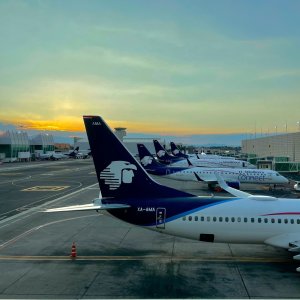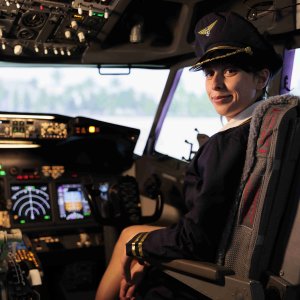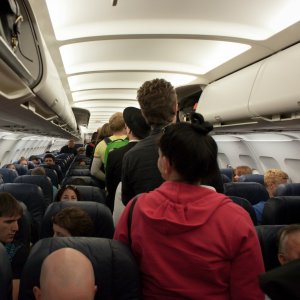
One Way Ticket to the Future of Commercial Aviation
 By Sofía Garduño | Journalist & Industry Analyst -
Wed, 04/27/2022 - 12:14
By Sofía Garduño | Journalist & Industry Analyst -
Wed, 04/27/2022 - 12:14
The pandemic brought challenges but also growth opportunities to the aerospace sector and, although Mexico’s aviation industry has seen a fast recovery from the COVID-19 pandemic, there are still numerous obstacles ahead, agreed industry experts.
While the slowdown in travel was widespread, the effects of the pandemic hit regions and airlines differently. For example, Viva Air Group experienced an unexpected growth in operations after the outbreak of the COVID-19. The airline now has 60 percent more passengers than it did before the sanitary crisis and was the only Colombian airline that did not file for Chapter 11 bankruptcy protection. In Sep. 2020, Viva Air restarted operations as an entirely different company, explained Felix Antelo, President and CEO, Viva Air Group. It now flies to 45 domestic destinations and 15 international ones. The fast recovery of Colombia’s aviation industry mirrors the one Mexico is experiencing.
“Colombia-Mexico is the fastest growing region in the world. This is because both countries faced the pandemic the best possible way they could, considering that there was no government support,” said Antelo. According to Ricardo Bastón, Chief Executive Officer, TAR Aerolineas, in Mexico the lack of government support prompted the industry to work together during the crisis. For TAR, connectivity was essential in enduring the pandemic, said Bastón.
Aeromexico, for its part, reported an increase in revenue of 114.3 percent in 4Q2021 versus 4Q2020. Its passenger traffic, however, fell 4.8 percent in the period compared to 4Q2020. The airline "will continue to expand operations safely in the coming months, in accordance with local regulations and customer demand and in full compliance with the highest standards and protocols,” said Aeroméxico in its 4Q2020 report.
Aside from the COVID-19 crisis, the Ukraine conflict is delaying the industry’s recovery by increasing fuel prices and hurting economies. These trends could further delay the sector’s recovery from the pandemic and change the future of commercial aviation.
“The world is reopening and traveling limitations are dropping; we will see a traveling boom,” said Antelo. In the future of aviation, Mexico will be an attractive destination despite the growing competition but high fuel prices and the shortage of qualified professionals could hamper the growth of the industry in Latin America. Consumers, on the other hand, are benefiting because it has never been less expensive to fly.
Giancarlo Mulinelli, Senior Vice President, Global Sales, Aeroméxico, forecasts a promising future for the region because Asians and Europeans are increasing their visits to Latin America. “We are in a very unique position as a region to capture that traffic,” he said. Corporate traveling is also expected to bounce back and vaccine tourism will remain in the spotlight. In the future of commercial aviation, Aeroméxico “wants to develop economies, bring job opportunities and make a positive impact for everybody,” added Mulinelli.
For years, technology has been an important ally of the aviation industry, which can now help it recover and transform. “It has never been easier to interact with an airline,” said Antelo. Viva Air Group has taken advantage of the acceleration in digitalization amid the COVID-19 pandemic. The group launched a WhatsApp channel to offer its services, become more responsive and lower costs. After the pandemic, costumers are increasingly demanding faster and simpler processes, which is why the airline heavily invested in a new website that has improved its services.
“Now customers like to fully have control and the pandemic has made people less tolerant,” said Mulinelli. To face this, Aeroméxico has invested in self-service tools and B2B platforms. It also improved its Club Premier program, bringing more benefits to users. The airline aims to continue innovating to simplify travel by putting its clients at the center.
While interconnection has brought several benefits for passengers, it also posed challenges to the industry, said Antelo. Regardless of the advantages that the connection that the online platforms offer, to build culture, people must interact with each other, he added. For that reason, the airline was the first in Colombia to go back to the office and currently, it continues to advocate for a hybrid model. Furthermore, he warns that the transition to full digital models will lead to the loss of 15 to 20 percent of corporate traffic.
To increase traffic, airlines should also look to improving passenger experience and rely on technology to improve cost management. The use of biometrics will become widespread, with China and the Middle East already implementing them in their traveling processes, said Bastón. He also highlighted the importance of using sustainable aviation fuels (SAF) and emerging transportation alternatives. “Innovation is positive and, as an industry, we are all taking advantage of it,” said Bastón.
















